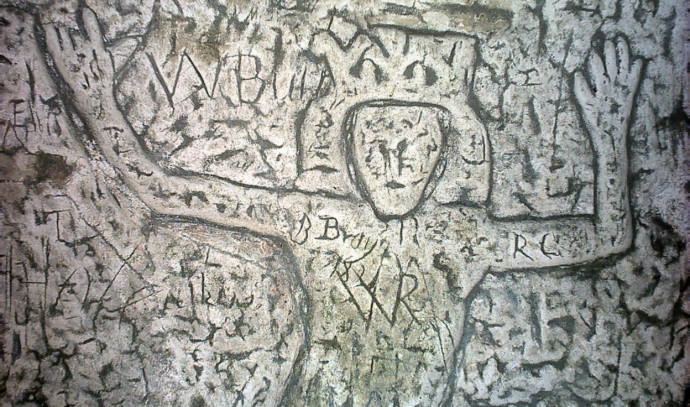Royston is a generic gray town in Hertfordshire County in England, but it turns out that for hundreds of years, no one has been able to solve its biggest mystery – the cave that hides beneath it.
The cave is a sort of round room that was carved into the limestone under the streets of Royston. It has a diameter of five meters and a height of eight meters, and on its walls, there are numerous carvings and etchings of incredible characters from a number of religious faiths.
The fascinating thing about the cave is that, despite the fact that it was discovered hundreds of years ago, to this day no one knows what it was used for. If you’re thinking of traveling to the area, Royston Cave is open to tourists on the weekends and holidays as well as throughout the summer months.
Images of Jesus and his apostles as well as a number of Christian saints can be found in the cave. Other characters, such as King David and Richard the Lionheart, are featured there as well.
The cave was discovered by accident in 1742 by a worker who was digging in order to build a booth at the local market. During the digging, he noticed a sort of marker made of stone. When he dug around it to move it, he found the hole leading to the cave. At the time, however, it was full of dirt, stones, and loads of sand that needed to be removed in order to access the space.
The cave’s discovery led to many theories over time
Some believed that treasure would be found in the cave, but after all the dirt was removed, no treasure was discovered. However, the carvings and etchings were.
At the base of the cave is a heightened step that many believe was used for kneeling in prayer. Along the lower part of the wall are outstanding carvings that experts believe were originally colored. However, due to degradation over time, little more than hints of the original color remained.
It also seems that holes under the carvings were used to hold candles or lamps that could light up the carvings and sculptures. Some of the characters and symbols have yet to be identified, but according to the Royston City Council, a study of the designs in the cave “led to the conclusion that they were made sometime in the middle of the 13th Century.”
One of the main theories of the origins of Royston Cave, especially among conspiracy theorists, is that it was used by the Templar Knights – a Christian order of hermit knights that was established in 1118 during the Crusades and later dismissed in 1312 by Pope Clemens V.
Architecture historian Nikolaus Pevsner wrote that “it’s difficult to guess the date of the carvings. They’ve been categorized as Anglo-Saxon, but they were most likely from various dates between the 14th and 17th Centuries.
Another theory is that Royston Cave was used as an Augustine storage. As the name suggests, the Augustines were an order that comes from Saint Augustine, a bishop in Algeria who died in 430. The order in his name was established in 1061, and they first reached England during the reign of King Henry I.
From the 12th Century, Royston was the center of monk life, and the Augustines lived there for almost 400 years. According to some of the estimations, local Augustine monks used Royston Cave as a cool place to store their food in addition to being used as a place of prayer.
Finally, some theorize that the cave was used as a neolithic flint mine in 3000 BCE when flint was collected to make axes and other tools. Still, limestone is only enough for small lumps of flint. These usually aren’t suited to making axes, so this theory is likely incorrect.
There is still no answer to the question of who created Royston Cave and for what purpose. It could be that whoever created it abandoned it at some point, allowing another group to use it. The mystery surrounding the cave as well as its sculptures and carvings make the cave an interesting place for visitors who are curious about religious mysteries and dark orders.



